RD Sharma Solutions Ex-8.3, Lines And Angles, Class 9, Maths | RD Sharma Solutions for Class 9 Mathematics PDF Download
Q 1: In the below fig, lines l1, and l2 intersect at O, forming angles as shown in the figure. If x = 45. Find the values of x, y. z and u.
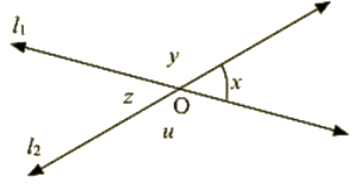
Ans : Given that
X = 45°, y =?, Z = ?, u=?
Vertically opposite angles are equal
Therefore z = x = 45
z and u are angles that are a linear pair
Therefore, z + u = 180
z = 180 – u
- u = 180 – x
- u = 180 – 45
- u = 135
x and y angles are a linear pair
- x+ y = 180
- y = 180 – x
- y =180 – 45
- y = 135
Hence, x = 45, y = 135, z = 135 and u = 45
Q 2 : In the below fig. three coplanar lines intersect at a point O , forming angles as shown in the figure. Find the values of x, y, z and u .
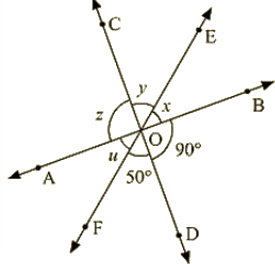
Ans : Vertically opposite angles are equal
So∠SOD = z = 90∘
∠DOF = y = 50∘
Now, x + y + z = 180 [Linear pair]
- x + y + z = 180
- 90 + 50 + x = 180
- x = 180 – 140
- x = 40
Hence values of x, y, z and u are 40, 50, 90 and 40 respectively in degrees.
Q 3 : In the given fig, find the values of x, y and z.

Ans : From the given figure
y = 25 [Vertically opposite angles are equal]
Now∠x+∠y = 180∘
[Linear pair of angles]
- x = 180 – 25
- x = 155
Also,
z = x = 155 [Vertically opposite angles]
y = 25
z = 155
Q 4 : In the below fig. find the value of x ?
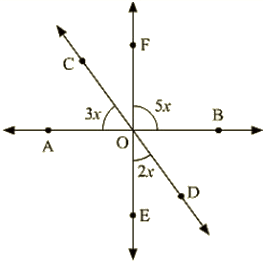
Ans : Vertically opposite angles are equal
AOE = BOF = 5x
Linear pair
∠COA+∠AOE+∠EOD = 180∘
- 3x + 5x + 2x = 180
- 10x = 180
- x = 180/10
- x = 18
Hence, the value of x = 18∘
Q 5 : Prove that bisectors of a pair of vertically opposite angles are in the same straight line.
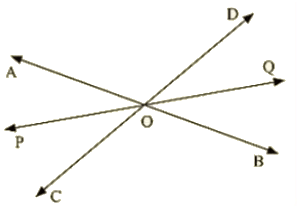
Ans : Given,
Lines A0B and COD intersect at point O, such that
/AOC – /BOO
Also OE is the bisector of ADC and OF is the bisector of BOD
To prove: EOF is a straight line, vertically opposite angles are equal
AOD = BOC = 5x —–(1)
Also ,
AOC +BOD
- 2 AOD = 2 DOF —–(2)
We know,
Sum of the angles around a point is 360
- 2 AOD + 2 AOE + 2 DOF = 360
- AOD + AOE + DOF = 180
From this we can conclude that EOF is a straight line.
Given that: – AB and CD intersect each other at O
OE bisects COB
To prove: AOF = DOF
Proof: OE bisects COB
COE = EOB = x
Vertically opposite angles are equal
- BOE = AOF = x —– (1)
- COE = DOF= x —– (2)
From (1) and (2),
∠AOF=∠DOF=x
Hence Proved.
Q 6 : If two straight lines intersect each other, prove that the ray opposite to the bisector of one of the angles thus formed bisects the vertically opposite angle.
Ans : Let AB and CD intersect at a point O
Also, let us draw the bisector OP of AOC
Therefore,
AOP = POC —–(i)
Also, let’s extend OP to Q.
We need to show that, OQ bisects BOD
Let us assume that OQ bisects BOD , now we shall prove that POQ is a line.
We know that,
AOC and DOB are vertically opposite angles. Therefore, these must be equal,
that is : AOC = DOB ` —–(ii)
AOP and BOQ are vertically opposite angles.
Therefore, AOP = BOQ
Similarly, POC = DOQ
We know that : AOP + AOD + DOQ + POC + BOC + BOQ = 360°
2 AOP + AOD +2 D0Q+ BOC =360°
2 AOP + 2 AOD + 2 DOQ = 360°
2( AOP + AOD + DOQ) = 360°
AOP + AOD +DOQ = 360 /2
AOP + AOD + DOQ = I 80°
Thus, POQ is a straight line.
Hence our assumption is correct. That is,
We can say that if the two straight lines intersect each other, then the ray opposite to the bisector of one of the angles thus formed bisects the vertically opposite angles.
Q 7 : If one of the four angles formed by two intersecting lines is a right angle. Then show that each of the four angles is a right angle.
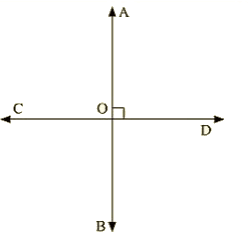
Ans : Given,
AB and CD are two lines intersecting at O, such that
∠BOC = 90,∠AOC = 90∠AOD = 90° and ∠BOD = 90
{figure}
Proof :
Given that B0C = 90
Vertically opposite angles are equal
BOC = AOD = 90
A0C, BOC are a Linear pair of angles
∠AOC+∠BOC = 180∘
[Linear pair]
- AOC + 90 = 180
- AOC = 90
Vertically opposite angles
Therefore, AOC = BOD = 90
Hence, AOC = BOC = BOD = AOD = 90
Q 8 : In the below fig. rays AB and CD intersect at O.
(I) Determine y when x = 60
(ii) Determine x when y = 40
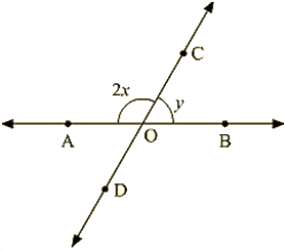
Ans : (i) Given x = 60
AOC, BOC are linear pair of angles
∠AOC+∠BOC = 180∘
⇒ 2x + y = 180
⇒ 2 (60)+ y = 180 [since x = 60]
⇒ y = 60
(ii) Given y = 40
AOC and BOC are linear pair of angles
∠AOC+∠BOC = 180∘
⇒ 2x + y = 180
⇒ 2x + 40 = 180
⇒ 2x =180 – 140
⇒ 2x = 140
⇒ x = 70
Q 9 : In the below fig. lines AB. CD and EF intersect at O. Find the measures of ∠AOC,∠COF,∠DOE and ∠BOF.
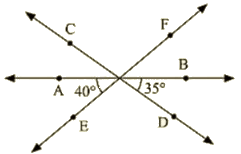
Ans : AOE and EOB are linear pair of angles
∠AOE+∠EOB = 180∘
∠AOE+∠DOE+∠BOD = 180∘
⇒ DOE = 180 – 40 – 35 = 105
Vertically opposite side angles are equal
DOE = COF =105
Now,∠AOE+∠AOF = 180∘
[Linear pair]
AOE + AOC + COF = 180
⇒ 40 + AOC +105 = 180
⇒ AOC = 180 – 145
⇒ AOC = 35
Also, BOF = AOE = 40 (Vertically opposite angles are equal)
Q 10 : AB, CD and EF are three concurrent lines passing through the point O such that OF bisects BOD. If BOF = 35. Find BOC and AOD.
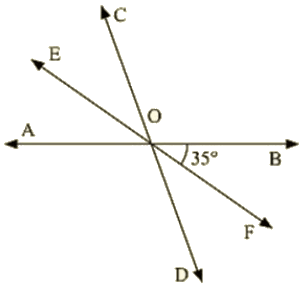
Ans : Given
OF bisects BOD
BOF = 35
Angles BOC and AOD are unknown
BOD = 2 BOF = 70 [since BOD is bisected]
BOD = AOC = 70 [ BOD and AOC are vertically opposite angles]
Now,
BOC + AOC = 180
BOC +70 = 180
BOC =110
AOD = BOC = 110 (Vertically opposite angles]
Q 11 : In below figure, lines AB and CD intersect at O. If ∠AOC+∠BOE = 70∘ and ∠BOD = 40∘, find ∠BOE and reflex ∠COE?
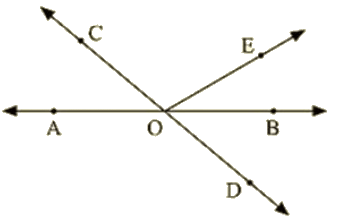
Ans : Given that
AOC + BOE = 70 and BOD = 40
To find BOE
Here , BOD and AOC an vertically opposite angles
BOD = AOC = 40
Given,∠AOC+∠BOE = 70∘,,
⇒ 40 + BOF = 70
⇒ BOF = 70 – 40
⇒ BOE = 30
AOC and BOC are lines pair of angles
⇒ AOC + COF + BOE = 180
⇒ COE = 180 – 30 – 40
⇒ COE = 110
Hence, Reflex COE = 360 – 110 – 250.
Q 12 : Which of the following statements are true (T) and which are false (F)?
(i) Angles forming a linear pair are supplementary.
(ii) If two adjacent angles are equal and then each angle measures 90
(iii) Angles forming a linear pair can both acute angles.
(iv) If angles forming a linear pair are equal, then each of the angles have a measure of 90
Ans : (i) True
(ii) False
(iii) False
(iv) true
Q 13 : Fill in Inc blanks so as to make the following statements true:
(i) If one angle of a linear pair is acute then its other angle will be______
(ii) A ray stands on a line, then the sum of the two adjacent angles so formed is ______
(iii) If the sum of two adjacent angles is 180, then the ______ arms of the two angles are opposite rays.
Ans :
(i) Obtuse angle
(ii) 180 degrees
(iii) Uncommon
FAQs on RD Sharma Solutions Ex-8.3, Lines And Angles, Class 9, Maths - RD Sharma Solutions for Class 9 Mathematics
| 1. What are the different types of angles and their properties? |  |
| 2. How do you find the angle between two intersecting lines? |  |
| 3. What are parallel lines and how can you identify them? |  |
| 4. What is the sum of the angles in a triangle? |  |
| 5. How can you determine if two lines are perpendicular? |  |





















